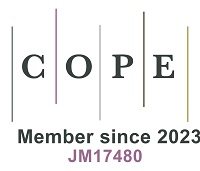REFERENCES
1. Lu, Y.; Yuan, J.; Lu, X.; et al. Major threats of pollution and climate change to global coastal ecosystems and enhanced management for sustainability. Environ. Pollut. 2018, 239, 670-80.
2. Murray, N. J.; Worthington, T. A.; Bunting, P.; et al. High-resolution mapping of losses and gains of Earth's tidal wetlands. Science 2022, 376, 744-9.
3. D'sa, E. J.; Tzortziou, M.; Liu, B. Extreme events and impacts on organic carbon cycles from ocean color remote sensing: review with case study, challenges, and future directions. Earth-Sci. Rev. 2023, 243, 104503.
4. Choudhary, B.; Dhar, V.; Pawase, A. S. Blue carbon and the role of mangroves in carbon sequestration: its mechanisms, estimation, human impacts and conservation strategies for economic incentives. J. Sea. Res. 2024, 199, 102504.
5. Wang, M.; Zhang, T.; Xie, Y.; Zhang, Z.; Wu, X. Mapping accumulated carbon storage of global mangroves from 2000 to 2020 at a 1 km resolution. Sci. Data. 2025, 12, 552.
6. Alongi, D. M. Carbon cycling and storage in mangrove forests. Ann. Rev. Mar. Sci. 2014, 6, 195-219.
7. Bandh, S. A.; Malla, F. A.; Qayoom, I.; et al. Importance of blue carbon in mitigating climate change and plastic/microplastic pollution and promoting circular economy. Sustainability 2023, 15, 2682.
8. Weiskopf, S. R.; Rubenstein, M. A.; Crozier, L. G.; et al. Climate change effects on biodiversity, ecosystems, ecosystem services, and natural resource management in the United States. Sci. Total. Environ. 2020, 733, 137782.
9. Hawkes, J. A.; Flygare, A. D.; Moodie, L. W. K.; Craig, A. J. Enhanced structural understanding of dissolved organic matter through comparative LC/MS2 analysis with synthetic carboxylate rich alicyclic molecules. Anal. Chem. 2025, 97, 18612-20.
10. Pradisty, N. A.; Amir, A. A.; Zimmer, M. Plant species- and stage-specific differences in microbial decay of mangrove leaf litter: the older the better? Oecologia 2021, 195, 843-58.
11. Liu, T.; Bao, K.; Chen, M.; Neupane, B.; Gao, C.; Zaccone, C. Human activity has increasingly affected recent carbon accumulation in Zhanjiang mangrove wetland, South China. iScience 2024, 27, 109038.
12. Wang, Z.; Hu, X.; Kang, W.; Qu, Q.; Feng, R.; Mu, L. Interactions between dissolved organic matter and the microbial community are modified by microplastics and heat waves. J. Hazard. Mater. 2023, 448, 130868.
13. Gao, H. Heterogeneity in composition and reactivity of dissolved organic matter and metal partitioning in soil. Wageningen University; 2025.
14. Jian, Z.; Xu, J.; Huang, X.; Yang, W.; Hu, Q. Optical absorption characteristics, spatial distribution, and source analysis of colored dissolved organic matter in wetland water around Poyang lake. Water 2021, 13, 274.
15. Alongi, D. M. Lateral export and sources of subsurface dissolved carbon and alkalinity in mangroves: revising the blue carbon budget. J. Mar. Sci. Eng. 2022, 10, 1916.
16. Herzsprung, P.; Kamjunke, N.; Wilske, C.; et al. Data evaluation strategy for identification of key molecular formulas in dissolved organic matter as proxies for biogeochemical reactivity based on abundance differences from ultrahigh resolution mass spectrometry. Water. Res. 2023, 232, 119672.
17. Merder, J.; Freund, J. A.; Feudel, U.; Niggemann, J.; Singer, G.; Dittmar, T. Improved mass accuracy and isotope confirmation through alignment of ultrahigh-resolution mass spectra of complex natural mixtures. Anal. Chem. 2020, 92, 2558-65.
18. Weishaar, J. L.; Aiken, G. R.; Bergamaschi, B. A.; Fram, M. S.; Fujii, R.; Mopper, K. Evaluation of specific ultraviolet absorbance as an indicator of the chemical composition and reactivity of dissolved organic carbon. Environ. Sci. Technol. 2003, 37, 4702-8.
19. Murphy, K. R.; Stedmon, C. A.; Graeber, D.; Bro, R. Fluorescence spectroscopy and multi-way techniques. PARAFAC. Anal. Methods. 2013, 5, 6557-66.
20. Darby, S. E.; Hackney, C. R.; Leyland, J.; et al. Fluvial sediment supply to a mega-delta reduced by shifting tropical-cyclone activity. Nature 2016, 539, 276-9.
21. Scavia, D.; Field, J. C.; Boesch, D. F.; et al. Climate change impacts on U.S. Coastal and Marine Ecosystems. Estuaries 2002, 25, 149-64.
22. Griffiths, L. N.; Mitsch, W. J. Estimating the effects of a hurricane on carbon storage in mangrove wetlands in Southwest Florida. Plants 2021, 10, 1749.
23. Jonsson, S.; Andersson, A.; Nilsson, M. B.; et al. Terrestrial discharges mediate trophic shifts and enhance methylmercury accumulation in estuarine biota. Sci. Adv. 2017, 3, e1601239.
24. Alongi, D. M. Current status and emerging perspectives of coastal blue carbon ecosystems. Carbon. Footprints. 2023, 2, 12.
25. Cao, F.; Tzortziou, M. Impacts of hydrology and extreme events on dissolved organic carbon dynamics in a heavily urbanized estuary and its major tributaries: a view from space. JGR. Biogeosci. 2024, 129, e2023JG007767.
26. Zeng, J.; Ai, B.; Jian, Z.; Ye, M.; Zhao, J.; Sun, S. Analysis of mangrove dynamics and its protection effect in the Guangdong-Hong Kong-Macao Coastal Area based on the Google Earth Engine platform. Front. Mar. Sci. 2023, 10, 1170587.
27. Zhang, Y. H.; Du, J. M. Background values of pollutants in sediments of the South China Sea. Acta. Oceanol. Sin. 2015, 4, 161-6. (in Chinese). Available from: http://hyxbocean.cn/en/article/id/20050422 [Last accessed on 14 Nov 2025].
28. Tang, T. J.; Han, L.; Peng, Y. Pollution and prevention countermeasure for water environment of Shenzhen bay. Environ. Sci. Manag. 2016, 41, 43-55. (in Chinese). Available from: https://kns.cnki.net/kcms2/article/abstract?v=sTAINAsmd8_rYc71em4TvC-qmWoo-OFwGF8--u-2es5QFJ_3V6fiAYBEW_bPV3Vz59Zfm0HL3v3I7joDi85lr2JKnm52Ub5HiCP4R7t_qG9M2u62FC9pmv0KkYnWmw1aEElSZ92hWWHwSGrm1LsqtDZgd4iqYCKTs_lY_9Qk04uymne5d1tQiA==&uniplatform=NZKPT&language=CHS [Last accessed on 14 Nov 2025].
29. Li, W.; Kuang, L.; Liu, Y.; Deng, P. Current status and prospect of water environment management in Shenzhen Bay. China. Water. Wastewater. 2016, 32, 29-41. (in Chinese).
30. Stedmon, C. A.; Bro, R. Characterizing dissolved organic matter fluorescence with parallel factor analysis: a tutorial. Limnol. Ocean. Methods. 2008, 6, 572-9.
31. Helms, J. R.; Stubbins, A.; Ritchie, J. D.; Minor, E. C.; Kieber, D. J.; Mopper, K. Absorption spectral slopes and slope ratios as indicators of molecular weight, source, and photobleaching of chromophoric dissolved organic matter. Limnol. Oceanogr. 2008, 53, 955-69.
32. Cory, R. M.; McKnight, D. M. Fluorescence spectroscopy reveals ubiquitous presence of oxidized and reduced quinones in dissolved organic matter. Environ. Sci. Technol. 2005, 39, 8142-9.
33. Ohno, T. Fluorescence inner-filtering correction for determining the humification index of dissolved organic matter. Environ. Sci. Technol. 2002, 36, 742-6.
34. Wilson, H. F.; Xenopoulos, M. A. Effects of agricultural land use on the composition of fluvial dissolved organic matter. Nat. Geosci. 2009, 2, 37-41.
35. Dittmar, T.; Koch, B.; Hertkorn, N.; Kattner, G. A simple and efficient method for the solid-phase extraction of dissolved organic matter (SPE-DOM) from seawater. Limnol. Ocean. Methods. 2008, 6, 230-5.
36. Wang, K.; Pang, Y.; Yi, Y.; et al. Response of dissolved organic matter chemistry to flood control of a large river reservoir during an extreme storm event. Water. Res. 2023, 230, 119565.
37. D'Andrilli, J.; Cooper, W. T.; Foreman, C. M.; Marshall, A. G. An ultrahigh-resolution mass spectrometry index to estimate natural organic matter lability. Rapid. Commun. Mass. Spectrom. 2015, 29, 2385-401.
38. Zhang, J.; Chen, Y. Risk assessment of flood disaster induced by typhoon rainstorms in Guangdong Province, China. Sustainability 2019, 11, 2738.
39. Shutova, Y.; Baker, A.; Bridgeman, J.; Henderson, R. K. Spectroscopic characterisation of dissolved organic matter changes in drinking water treatment: from PARAFAC analysis to online monitoring wavelengths. Water. Res. 2014, 54, 159-69.
40. Tomco, P. L.; Zulueta, R. C.; Miller, L. C.; Zito, P. A.; Campbell, R. W.; Welker, J. M. DOC export is exceeded by C fixation in May Creek: a late-successional watershed of the Copper River Basin, Alaska. PLoS. One. 2019, 14, e0225271.
41. Lin, H.; Guo, L. Variations in colloidal DOM composition with molecular weight within individual water samples as characterized by flow field-flow fractionation and EEM-PARAFAC analysis. Environ. Sci. Technol. 2020, 54, 1657-67.
42. Yamashita, Y.; Sanchez, G.; Kawai, K.; Tomano, S.; Fujita, H.; Umino, T. The role of the isolation of the marginal seas during the Pleistocene in the genetic structure of black sea bream Acanthopagrus schlegelii (Bleeker, 1854) in the coastal waters of Japan. PeerJ 2021, 9, e11001.
43. Matos, C. R.; Berrêdo, J. F.; Machado, W.; et al. Seasonal changes in metal and nutrient fluxes across the sediment-water interface in tropical mangrove creeks in the Amazon region. Appl. Geochem. 2022, 138, 105217.
44. Taillardat, P.; Ziegler, A. D.; Friess, D. A.; et al. Assessing nutrient dynamics in mangrove porewater and adjacent tidal creek using nitrate dual-stable isotopes: a new approach to challenge the Outwelling Hypothesis? Mar. Chem. 2019, 214, 103662.
45. Adame, M. F.; Virdis, B.; Lovelock, C. E. Effect of geomorphological setting and rainfall on nutrient exchange in mangroves during tidal inundation. Mar. Freshwater. Res. 2010, 61, 1197-206.
46. Davis, S. E.; Corronado-Molina, C.; Childers, D. L.; Day, J. W. Temporally dependent C, N, and P dynamics associated with the decay of Rhizophora mangle L. leaf litter in oligotrophic mangrove wetlands of the Southern Everglades. Aquatic. Botany. 2003, 75, 199-215.
47. Romero, L. M.; Smith, T. J.; Fourqurean, J. W. Changes in mass and nutrient content of wood during decomposition in a south Florida mangrove forest. J. Ecol. 2005, 93, 618-31.
48. Tan, L. S.; Ge, Z. M.; Li, S. H.; et al. Impacts of land-use change on carbon dynamics in China's coastal wetlands. Sci. Total. Environ. 2023, 890, 164206.
49. Kaiser, K.; Guggenberger, G. The role of DOM sorption to mineral surfaces in the preservation of organic matter in soils. Org. Geochem. 2000, 31, 711-25.
50. Lalonde, K.; Mucci, A.; Ouellet, A.; Gélinas, Y. Preservation of organic matter in sediments promoted by iron. Nature 2012, 483, 198-200.
51. Riedel, T.; Zak, D.; Biester, H.; Dittmar, T. Iron traps terrestrially derived dissolved organic matter at redox interfaces. Proc. Natl. Acad. Sci. USA. 2013, 110, 10101-5.
52. Jiao, N.; Herndl, G. J.; Hansell, D. A.; et al. Microbial production of recalcitrant dissolved organic matter: long-term carbon storage in the global ocean. Nat. Rev. Microbiol. 2010, 8, 593-9.
53. Wang, H.; Zhang, Q. W.; Chen, G.; et al. The loss of dissolved organic matter from biological soil crust at various successional stages under rainfall of different intensities: Insights into the changes of molecular components at different rainfall stages. Water. Res. 2024, 257, 121719.
54. Eckard, R. S.; Pellerin, B. A.; Bergamaschi, B. A.; et al. Dissolved organic matter compositional change and biolability during two storm runoff events in a small agricultural watershed. JGR. Biogeosci. 2017, 122, 2634-50.








